Do-it-yourself ventilation device in a house with gas appliances
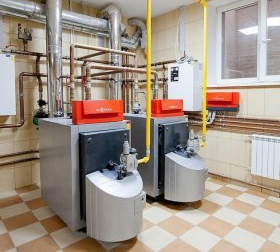
A room ventilation device is necessary for organizing continuous air renewal. This is especially important if gas-flame appliances are present in the house - heating boilers, water heaters and stoves. When starting to equip ventilation devices, you need to carefully study the rules for their arrangement and clearly follow them when designing and installing.
Content
The role of ventilation in a room with a gas boiler
The process of burning fuel in a gas boiler occurs with the active participation of atmospheric oxygen. Therefore, its content in the boiler room decreases rapidly, gas combustion becomes incomplete, which is why soot settles more actively on the walls of the chimney, and it becomes stuffy in the room. The well-being of a person in such conditions can dramatically worsen until the loss of consciousness.
The situation may be complicated if gas leaks form the internal gas pipeline in the house. The situation becomes explosive with possible grave consequences.
To prevent this from happening, a ventilation system should be installed in every room with gas appliances. It allows you to continuously refresh the room by supplying fresh air from the outside and removing contaminated.
When building a bath, it is also important to consider the arrangement of a high-quality ventilation system. How to provide air exchange to make the room comfortable, read in our article:https://aquatech.tomathouse.com/en/ventilyaciya/kak-sdelat-ventilyatsiyu-v-bane-3.html.
Ventilation requirements in a private house with a gas boiler
For private homes, gas boilers of small capacity are most often used - up to 30 kilowatts. For their installation, free-standing boiler rooms are not required. Such equipment can even be placed in kitchens that meet the following requirements:
- room area over 15 m2;
- ceiling height not less than 2.2 m;
- area of window openings more than 3 cm2 on 1 m3 volume of the room. The window should open fully or be equipped with a window;
- the presence of forced ventilation through openings on the bottom of the door (4-5 openings with a diameter of at least 20 mm);
- the distance from the wall of non-combustible material to the boiler is at least 10 cm. It is allowed to install an additional cement-bonded particleboard or metal sheet to cover the wall section near the boiler.
In addition to the ventilation device, some special requirements are imposed on the installation site of the boiler. Boilers are allowed to arrange:
- in premises attached to a residential building;
- in separate buildings;
- in the attics;
- in separate rooms in the house.
Boilers are often equipped in the basement or basement of a building. This does not apply to LPG devices. Its density is higher than that of air and, if a leak develops, it can accumulate on the floor, being initially invisible at the height of human growth. This creates an explosive atmosphere.
Standardization of ventilation during operation of gas boilers
It should be noted that gas equipment is a source of increased danger. Therefore, the procedure for designing and operating boiler rooms is standardized by the state, and compliance with these requirements is strictly controlled by it.
To streamline all requirements, the “Building Standards and Rules 2.04.05. II-35 ”, and II-35–76. The basic requirements for premises for gas boilers are described above.
This document also governs:
- the procedure for the development of technical documentation;
- sizes and capacities of ventilation systems for different types of buildings;
- their types and arrangement.
How to arrange the ventilation of a gas boiler in a private house
There are several types of ventilation for rooms with gas boilers:
- supply;
- exhaust;
- supply and exhaust;
- natural.
None of the listed species is practically applied separately. The most effective ventilation methods are combinations of these methods in various combinations.
Natural ventilation
This is the most common and mandatory way to supply fresh air to the boiler room.
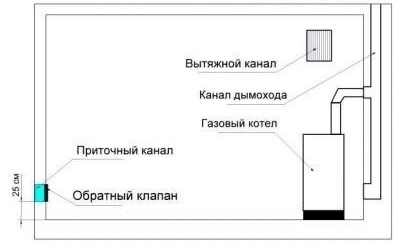
In the natural ventilation system, air enters through the inlet openings at the bottom of the room and is removed through the upper exhaust ducts due to natural circulation
The manufacture of the ventilation duct is as follows:
- Marking is made on the diameter of the pipe with a margin of approximately 10 mm. The diameter of the duct pipe must be at least 15 cm.
- A hole is drilled. You can use a carbide tipped drill (for walls made of building stone) or a special crown.
- The ventilation pipe is installed in the opening made for it with a slight slope towards the street.
- The gap is filled with foam.
- When the foam has hardened, its protruding edges are removed and a damper is installed to adjust the amount of airflow passage. The disadvantage of this solution is the fact that debris and dust are applied through the channel. To eliminate this drawback, a grill with a filter was installed in the pipe, which created the need for forced blowing with a built-in fan. Thus, the natural inflow became forced.
When choosing a place for installing the ventilation duct, one should take into account the fact that its outlet must be at least a meter away from the boiler, then cold air from it will not affect the operation of the unit. Of course, modern automation can easily cope with this circumstance, but there is no need to overload it unnecessarily.
The effect on the ventilation duct natural ventilation environmental conditions, including weather, but one of its advantages is undeniable - it will work regardless of the mains, providing a constant flow of air from the outside.
Video: how to make a ventilation duct for a boiler room
Forced exhaust ventilation
Combined supply and exhaust systems with extensive adjustment options consist of fans, filters and air heaters. In essence, these are climate systems. Considering that modern boilers are equipped with various regulators that automatically control its operation depending on the microclimate in the boiler room, the use of such ventilation devices ensures optimal operation of the heating unit and contributes to significant fuel economy.
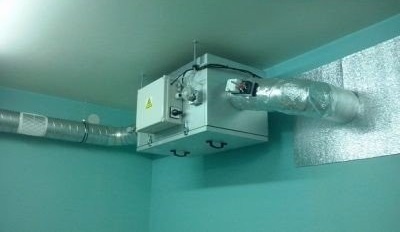
Supply ventilation systems supply and extract air due to the operation of fans installed in the laid channels
In our next article, detailed instructions for the installation of supply and exhaust ventilation with calculations are presented:https://aquatech.tomathouse.com/en/ventilyaciya/pritochno-vyityazhnaya-ventilyatsiya-v-chastnom-dome.html.
Duct and free ventilation systems
One of the characteristics for the classification of ventilation systems is their design features and the method of moving air.
The channel ventilation system provides for the creation or use of specially designed ducts, due to the design of the building. At the same time, various niches are used, the installation space of the suspended ceiling, ventilation shafts. In places where such elements are not provided for in the building structure, ventilation ducts are laid directly along the walls and mask with details of the room's decoration.
It should be noted that the ventilation of the building cannot be considered only for a separate room, even if it is as specific as a boiler room. All air flows are combined into a single system and are removed from the house by force or naturally. Gas equipment can be used in the kitchen (stove), bathroom (gas water heater), living room (gas fireplace). The principles of air exchange in all these objects are subject to the same requirements.
The main means of transporting air are pipes. Most popular:
- rectangular galvanized steel products. They are convenient to install, always provided with components - corners, bends, etc .;
- corrugated aluminum pipes. Almost do not require additional fittings, as they themselves are flexible products. Comfortable enough to work with;
- plastic ducts of rectangular and circular cross section.
All mentioned products can be retrofitted with decorative grilles of air intakes, gates, connecting elements. Thanks to their application, installation of the air duct has become simple and affordable to do it yourself even without the appropriate qualifications.

The small size and weight of the duct elements and the presence of all the necessary fasteners and fittings allows you to build a ventilation duct of any configuration with your own hands
The procedure for installing the supply and exhaust ventilation in the boiler room with your own hands:
- Punch holes in the wall to install the air intake.
- Install the pipe with a reverse slope in the hole, fix the mounting foam.
- Attach a safety net to the outside of the air intake.
- Connect the axial fan if forced ventilation is installed. Mount the check valve.
- Connect the duct pipe to the umbrella on the boiler, ensure tightness with a tightening clamp.
- Mount the duct of the ventilation duct with the output through the roof or wall of the house.
- Install the head on the ventilation pipe.
Video: which pipes to use for ventilation
Calculation of the ventilation section
In order to correctly calculate the cross section of the pipeline ventilation system of the boiler room, the following data will be needed:
- The cubic capacity of the boiler room, depending on the height of the room. According to the requirements of SNiP, its height should not be less than 6 meters. Obviously, in a country house, such a requirement is not feasible. When calculating, it must be taken into account that when this indicator is reduced by 1 meter, the amount of air required for fuel combustion must be increased by 25%;
- Air mass flow rate (not less than 1 m / s).
- Multiplicity of air exchange. The value depends on the height of the boiler room.
The result of the calculation will be the need for air, based on which, using special tables, you can determine the cross section of the pipeline ventilation system.
The calculation is made using the relation V = L x S X (6 - H) x 1.25 x n, where:
- V is the volume of air for fuel combustion;
- L — length of the room;
- S — the width of the room;
- H — room height;
- n — frequency of air change in the boiler room, equal to 3.
Thus, when determining the need for air, the actual dimensions of the room and the value of the increase in air turnover are taken into account. Having received the desired value, the diameter of the duct can be selected from the table.
Table: the dependence of the diameter of the duct on the required air flow
| Diameter air duct, mm |
Air consumption in m3/ hour at a speed in m / s | |||||||
| 1 | 2 | 3 | 4 | 5 | 6 | 7 | 8 | |
| 100 | 28,3 | 56,5 | 84,8 | 113 | 141 | 170 | 198 | 226 |
| 125 | 44,2 | 88,3 | 132 | 177 | 221 | 265 | 309 | 353 |
| 140 | 55,4 | 111 | 166 | 222 | 277 | 332 | 388 | 443 |
| 160 | 72,3 | 45 | 217 | 289 | 362 | 434 | 506 | 579 |
| 180 | 91,6 | 183 | 275 | 366 | 458 | 549 | 641 | 732 |
| 200 | 113 | 226 | 339 | 452 | 565 | 678 | 791 | 904 |
| 225 | 143 | 286 | 429 | 572 | 715 | 858 | 1001 | 1145 |
| 250 | 177 | 353 | 530 | 707 | 883 | 1060 | 1236 | 1413 |
For ventilation of rooms with gas appliances, it is advisable to arrange a duplicated ventilation system so that one of them works in any circumstances.
In the event of a power outage, the ventilation of the premises will be carried out through natural circulation channels.
Video: calculation of air exchange in the boiler room
Ventilation Testing
The quantitative characteristics of traction are measured using a device for measuring wind strength. Its impeller must be placed inside the ventilation duct and determine this indicator on a scale. Knowing the value of the cross-section of the pipeline, it is easy to calculate the performance of the system, that is, its sufficiency to provide the required amount of air in the room for normal combustion in the boiler.
Separately, boilers are closed burning with coaxial chimneys. In them, air is supplied to the furnace directly from the atmosphere through pipes of a special design, and the room air does not participate in combustion.
The ventilation duct of the boiler room must not be connected to the air ducts of the common exhaust. This will avoid the spread of gas throughout the house.
You may also find useful material on the certification of ventilation systems:https://aquatech.tomathouse.com/en/ventilyaciya/pasport-ventilyatsionnoy-sistemyi.html
The main causes of draft deterioration in the ventilation system
Among those, it should be noted:
- Difficulties in the flow of outside air into the boiler room after replacing traditional window units with double-glazed windows. Their tightness significantly reduces the possibility of air penetration;
- the same consequences after replacing the doors, if the gap between the floor and the bottom edge is minimal or absent;
- decrease in natural traction in the hot season due to a decrease in the temperature difference outside and inside the house;
- the appearance of stagnant zones or zones with reduced pressure during strong winds in the atmosphere, which also negatively affects the operation of ventilation systems, therefore in such conditions additional traction control is needed.
When operating forced ventilation of a boiler room, it is necessary to select fans with an impeller that does not spark from blows. Products made of aluminum alloys, copper or plastic are suitable for this.
Insufficiency of the ventilation system of a gas boiler is dangerous not only for health but also for human life. In addition, it reduces the heating efficiency. Excessive ventilation leads to a violation of the thermal regime, worsening the living conditions in the house. When starting to install ventilation yourself, try to get expert advice and take into account his comments. I wish you success!

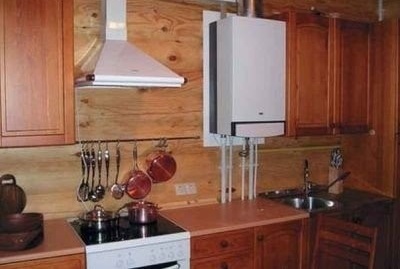
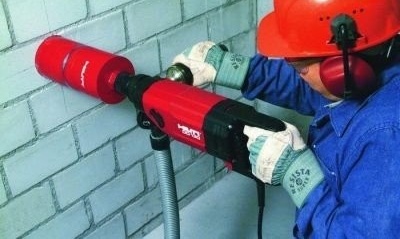

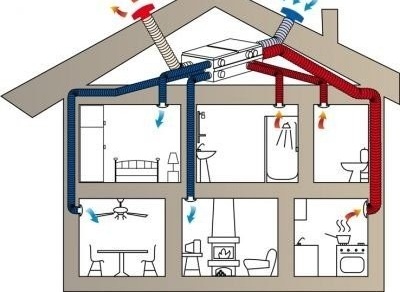
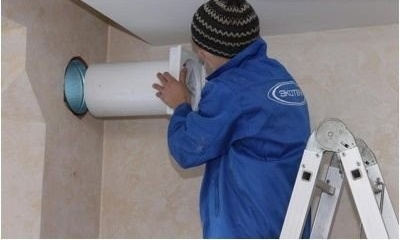

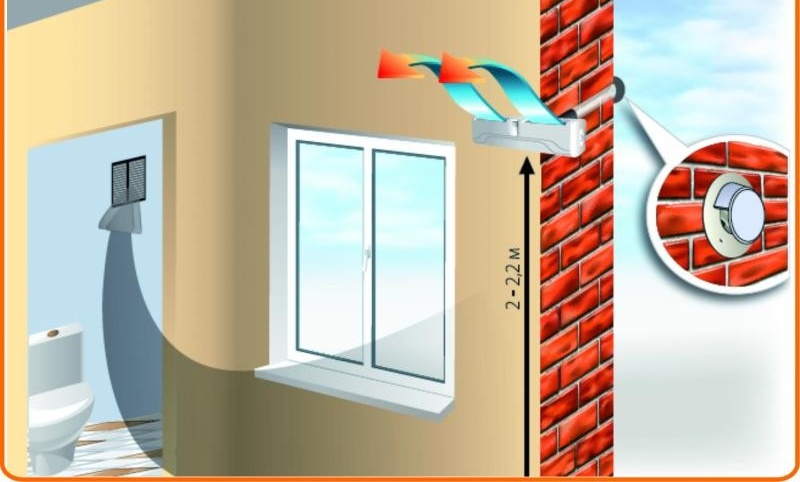


1 comment